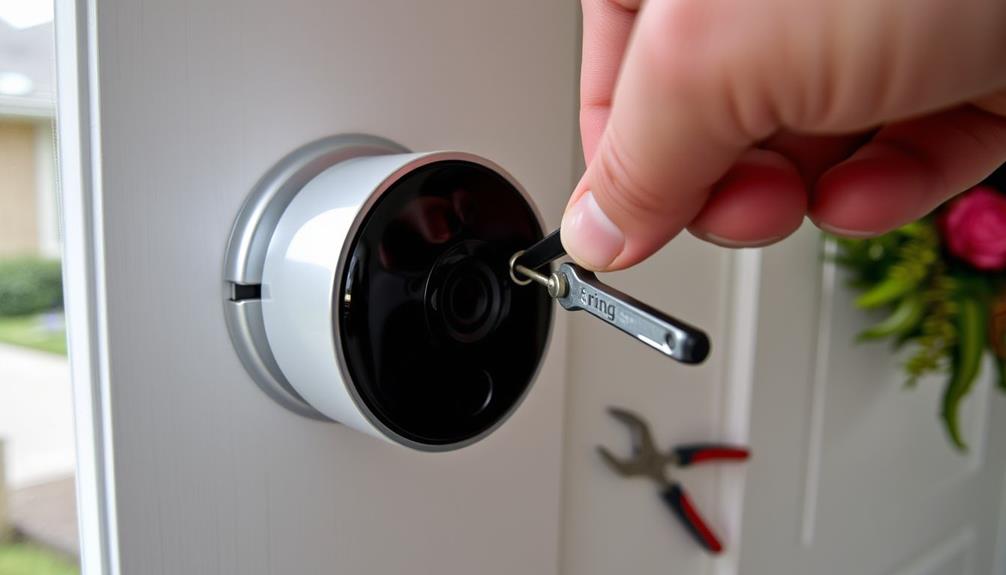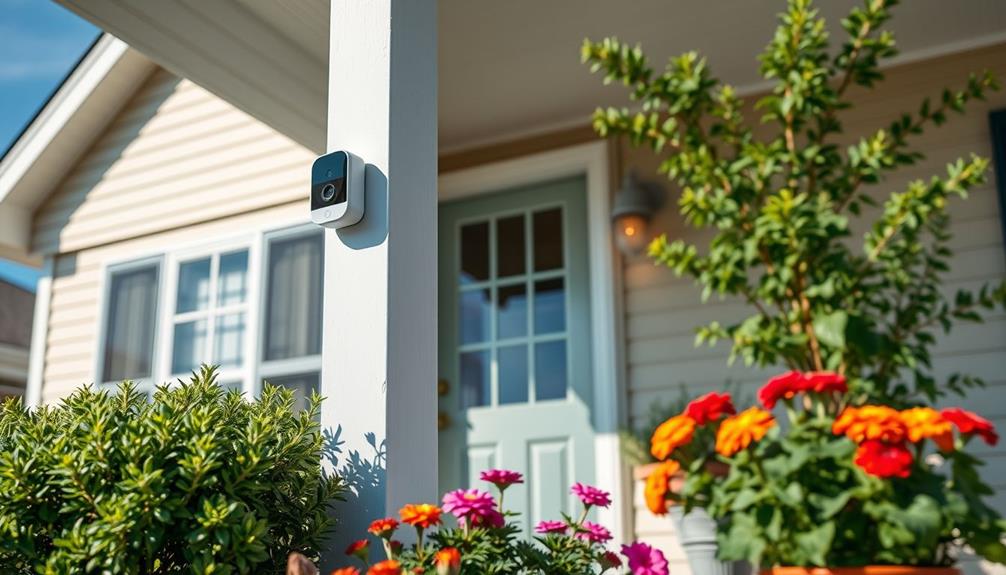To replace your Ring Doorbell, start by gathering your tools, turn off the power at the breaker, and charge the battery for a few hours. Carefully remove the old doorbell faceplate and detach the power wires, noting their arrangement. Mount the new Ring Doorbell using the existing hole or drill new one if necessary. Connect the wires as you noted before restoring power. Check for the light indicator, test the doorbell button, and verify the live feed works through the app. There's more to learn about optimizing your setup and troubleshooting common issues.
Key Takeaways
- Turn off power at the breaker box and use a voltage tester to ensure safety before removing the old doorbell.
- Carefully detach the old doorbell by removing the faceplate and unscrewing the power wires, noting their arrangement for the new installation.
- Position the new Ring Doorbell over the existing hole, mark screw holes, and drill pilot holes as necessary for secure mounting.
- Connect the doorbell wires according to the noted arrangement, using wire connectors and including a diode if using a digital chime.
Installation Preparation
Before you start replacing your Ring doorbell, make certain you've gathered all the necessary tools and prepared your workspace for a smooth installation. You'll need a screwdriver, screws, and the charging cable from your Ring doorbell kit. If you're installing on brick or stucco, grab a drill and masonry bit as well. Consider using smart organization techniques to keep your tools and materials easily accessible during the installation process.
Next, charge the battery of your Ring Video Doorbell 2 for four to six hours using the provided charging cable. This guarantees it operates properly once you complete the installation process. Safety is key, so shut off power to the existing doorbell at the breaker box before you begin.
When you're ready, you'll need to prepare for the removal of the old doorbell. Use your screwdriver or a box cutter to detach the faceplate carefully, exposing the power wires. It's also crucial to follow the manufacturer guidelines closely to avoid any defects during installation. If you're using a hardwired model, double-check the power supply compatibility before proceeding.
With your tools in hand and preparations made, you're set to move forward with the installation of your new Ring doorbell.
Removing the Old Doorbell

Before you start removing the old doorbell, gather the necessary tools like a screwdriver or box cutter.
It's also crucial to guarantee you have a clear understanding of the process, as what to expect from professional services can provide valuable insights into the best practices.
You'll want to use proper techniques to avoid damaging the wires and guarantee safety throughout the process.
Getting this step right sets you up for a smooth installation of your new Ring doorbell.
Necessary Tools Required
To successfully remove the old doorbell, you'll typically need a screwdriver or box cutter, along with a flathead screwdriver for disconnecting the wires. These tools are vital for detaching the faceplate and unscrewing the device from the wall.
First, make sure that the power is turned off at the breaker to avoid any electrical hazards while working on the old doorbell. Utilizing tools effectively can also be significant for AI in Cybersecurity by enhancing threat detection and response times, highlighting the importance of being prepared in any task.
Once the power's off, use your screwdriver or box cutter to carefully remove the faceplate. After that, grab the flathead screwdriver to loosen and disconnect the wires from the back of the doorbell. It's important to handle the power wires gently to prevent any damage.
If your doorbell's mounted on a brick or stucco wall, you might also need a drill to create new holes for the installation. Having these tools ready will make the process smoother and safer.
Proper Removal Technique
Carefully removing the old doorbell involves using your screwdriver or box cutter to take off the faceplate, which reveals the screws underneath. Once you've exposed the screws, use your screwdriver to unscrew the old doorbell from the wall. Gently pull it away to access the power wires connected to it. It's vital to handle these wires with care during the removal process to avoid any damage.
Next, loosen the screws that hold the wires in place, making sure you detach them completely. Take note of how the wires are arranged, as this information will be significant when you connect the new Ring doorbell. This removal technique not only guarantees that you safely detach the old doorbell but also prepares you for a smooth installation of your new device.
Before moving forward, double-check that the old doorbell is fully removed. Leaving any remnants could cause interference with the new installation. By following these steps diligently, you'll make the changeover seamless and set yourself up for success with your new Ring doorbell.
Safety Precautions Needed
It's important to turn off the power at the breaker box to prevent electrical shock while removing the old doorbell. This action cuts the power to your doorbell, ensuring a safe working environment.
After that, grab a voltage tester to confirm that no current is running through the wires. It's vital to double-check, as this can save you from potential hazards.
When you start removing the old doorbell, make sure to wear safety goggles to protect your eyes from any debris. Be cautious with the existing wiring; damaged wires can create safety hazards or lead to your new device malfunctioning.
If your doorbell is secured with safety screws, have the right tools ready for easy removal.
If at any point you feel unsure about the process, don't hesitate to consult the installation instructions or seek professional help. Your safety is the priority, and taking these precautions can make a significant difference.
Mounting the New Doorbell

When you're ready to mount your new Ring Doorbell, make certain it's positioned correctly over the old doorbell's hole.
You'll need to mark the screw holes and choose the right anchors based on your wall type for a secure fit.
Proper placement guarantees your doorbell functions effectively and stays stable over time.
Proper Mounting Techniques
Position your new Ring Doorbell over the hole left by the old doorbell, and check the live video feed through the Ring app for the best viewing angle before marking screw hole locations.
Use a level tool to guarantee your doorbell is straight. When you're ready, drill pilot holes for the mounting screws, making sure to use a masonry drill bit if you're mounting on brick or stucco.
For wood or vinyl surfaces, you won't need anchors. As you attach the mounting bracket, gently tighten the security screws—avoid overtightening, as this may bend the bracket and affect functionality.
If you're connecting to an existing doorbell chime, verify that the wires don't touch each other. Secure the connections by tightening the screws gently.
Once everything is in place, align the Ring Video Doorbell with the bracket and press down firmly until you hear a click, confirming it's securely mounted.
This careful mounting process helps guarantee your doorbell functions correctly and captures clear video footage.
Ensuring Secure Placement
Guaranteeing your Ring Doorbell is securely mounted is key to its proper functionality and performance. Start by positioning the mounting bracket over the existing hole left by the old doorbell. Use the Ring app to check the live video feed and find the best angle. Mark the screw hole locations with a pencil after confirming the bracket is level. This will help you maintain proper alignment during installation.
| Surface Type | Drill Requirement |
|---|---|
| Brick | Use included masonry bit |
| Stucco | Use included masonry bit |
| Wood | No anchors needed |
| Vinyl | No anchors needed |
For brick or stucco surfaces, drill anchor holes as needed. Remember, avoid overtightening screws during installation to prevent bending the bracket, which can affect the doorbell's functionality. Once you've pressed the Ring Doorbell onto the bracket and heard it click, check for stability to guarantee it has a secure placement. Finally, restore power and enjoy your new doorbell!
Connecting the Doorbell Wires

To successfully connect the doorbell wires, start by properly identifying and labeling the wires from your existing doorbell to prevent any mix-ups during installation. This step is vital for connecting the doorbell wires correctly when installing your Ring Replacement Doorbell.
Next, loosen the screws on the mounting bracket, allowing you to wrap the exposed ends of the wires around the corresponding terminals. Typically, these are marked as positive and negative connections. After securing the wires, make certain they don't touch each other to avoid electrical shorts that could lead to malfunctions.
If you're using a digital chime, it's critical to include a diode in the wiring according to the installation instructions to protect the chime from damage.
Here's a quick checklist to follow during this process:
- Identify and label existing doorbell wires
- Wrap wires around the correct terminals
- Make certain wires don't touch each other
Restoring Power

Once you've connected the doorbell wires, the next step is to restore power to your Ring doorbell by flipping the breaker switch back on. This will allow your device to receive electricity and function properly.
After restoring power, check if your existing doorbell chime activates. If it doesn't, double-check your connections to verify everything is in place.
For those with digital chimes, you might need to reverse the diode installation if the chime doesn't sound after you've restored power.
It's also vital to secure the faceplate of your Ring doorbell using the included security screws. This step is important, as it keeps your device functional and protects it from the elements.
Once everything is in place, you can confirm that your Ring doorbell is working as intended. Make sure to press the button and check that you receive notifications on the Ring app.
If everything goes smoothly, you're all set! Restoring power is a significant step in guaranteeing your new doorbell operates correctly, so take your time to do it right.
Testing the Device

It's important to test your Ring doorbell after restoring power to confirm it's working properly. You'll want to verify that all functions are operational, so follow these steps:
- Check the power: Look for the light indicator on the doorbell to confirm it's on.
- Test the doorbell button: Press the button to see if the connected chime activates correctly.
- Verify the live video feed: Open the Ring app to check if the camera captures video and streams live.
Managing Subscriptions

After ensuring your Ring doorbell is functioning properly, you can easily manage your Ring Protect subscription to enhance your security experience.
Start by logging into your Ring account via the Ring app or the website. Here, you can view and update your plan details at any time.
The Ring Protect Basic Plan covers only one device, while the Protect Plus Plan provides coverage for multiple devices under a single subscription. This flexibility means you can choose a plan that best suits your needs.
If you decide to cancel or change your subscription, you can do so seamlessly through the Ring app.
Both plans include recorded video storage, but the amount varies based on your selected plan.
If you add new devices to an existing Protect Plus Plan, you won't need a separate subscription for those devices, making it easier to manage your Ring account.
Troubleshooting Common Issues

Troubleshooting common issues with your Ring doorbell can help restore its functionality and enhance your security experience. If you're facing connectivity problems or concerns about battery life, there are several steps you can take to resolve these issues effectively.
First, check your Wi-Fi signal strength. A weak connection can lead to performance problems. Consider the following tips:
- Position your router closer to the doorbell.
- Avoid obstructions like walls or large furniture.
- Restart your router to refresh the connection.
If you're having battery life issues, monitor your battery levels regularly. Recharge as needed to maintain peak functionality. Keep in mind that high traffic on your network or frequent motion alerts may drain the battery faster.
Lastly, if problems persist, consider reaching out to the Ring Community or checking their documentation for additional troubleshooting tips. Remember, addressing these common issues promptly can greatly improve your Ring doorbell's performance and guarantee your home remains secure.
Community Support Resources

The Ring Community serves as a valuable resource where you can connect with other users to share experiences and seek advice on your Ring devices. By joining the community, you gain access to a wealth of knowledge about installation and troubleshooting issues. If you run into a problem, don't hesitate to post a question; chances are, someone else has faced a similar challenge and can offer helpful insights.
To get started, you'll need to register, which helps create a more engaged and supportive environment. Once you're in, you can browse existing posts and discussions, enhancing your understanding of Ring products.
You'll find that community support resources are plentiful, with both fellow users and Ring representatives often providing helpful responses. Participating in these discussions not only helps you resolve your issues but also contributes to the collective knowledge of the community.
Your feedback can even influence future product offerings, ensuring that user experiences shape Ring's development process. So, jump in, join in the discussion, and make the most of the support available to you!
Frequently Asked Questions
Is It Easy to Replace Ring Doorbell?
Yes, it's easy to replace a Ring doorbell. You can install the new device without removing the old one, making the process straightforward.
Just follow the step-by-step instructions in the Ring app, which guides you through the setup. Most users finish everything in under an hour, especially if they're familiar with the app.
You'll also be able to manage multiple doorbells within your account, streamlining your smart home experience.
Can You Change the Ring Doorbell?
Yes, you can change your Ring Doorbell easily!
You just need to add the new device through the Ring app, and you won't have to remove the old one first.
Once you install the new doorbell, the old one will be automatically deleted from your account.
If you're on a Ring Protect Plan, your subscription will transfer seamlessly, keeping your coverage intact.
Just make sure the new doorbell's compatible with your power supply!
How Do You Remove an Old Ring Doorbell?
Removing an old doorbell's like peeling an orange—start with the skin.
First, you'll take off the faceplate using a screwdriver or box cutter.
Next, unscrew the mounting screws, then gently pull it away from the wall.
You'll find the power wires; carefully disconnect them by loosening the screws.
Just make sure you've fully detached it before moving on.
Don't forget your tools—like a drill for tougher surfaces!
How Do I Replace an Existing Doorbell?
To replace an existing doorbell, start by ensuring the power supply matches your new device.
If it's hardwired, connect the existing wires carefully, making sure they don't touch.
Once connected, install the new doorbell and use the app to set it up. This will let you access features like live video and notifications.
If you have a subscription plan, it'll transfer automatically, keeping your coverage intact.
Conclusion
To sum up, replacing your Ring doorbell can enhance your home security and convenience.
Did you know that homes with video doorbells are 50% less likely to be targeted by burglars?
By following the steps outlined, you'll not only upgrade your home's safety but also gain peace of mind.
Remember to manage your subscriptions and utilize community support resources for any questions.
With your new doorbell in place, you're one step closer to a more secure home!









